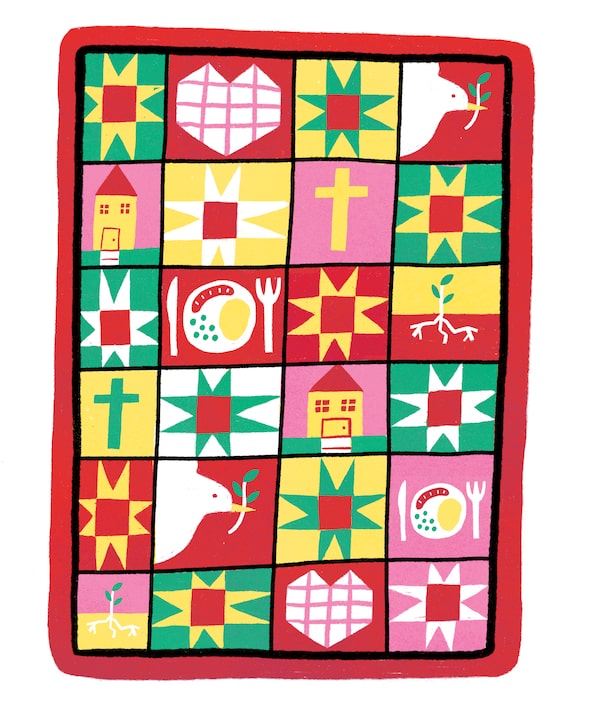
Sandi Falconer/THE GLOBE AND MAIL
First Person is a daily personal piece submitted by readers. Have a story to tell? See our guidelines at tgam.ca/essayguide.
“Shall we say grace?”
My mother looks to my father for input. The smell of baked bread, steamed green beans and barbecued trout wafts from the dinner table. It’s framed as a question, but there is only one answer. It is the same answer it has always been.
“Thank you, God,” my mother begins, eyes closed and head bowed. I sneak one last glance at the food on the table; my appetite will have to wait.
Some run marathons; some fast or meditate. My mother is a world-class endurance athlete in dinnertime prayer. Short-haired and with reading glasses perched just right, she can out-thank the most grateful of grace-givers. Oscar acceptance speeches are shorter. Maybe Oscar monologues, too. Still, for every breakfast, lunch and dinner my family has shared, my parents have started by giving thanks.
I was raised a Mennonite, which is not to be confused with an Old Colony Mennonite, nor an Old Order Mennonite, and certainly not a David Martin Mennonite (although my parents did name me Martin David). I am neither a Mexican Mennonite (who themselves are not really Mexican, but rather Low German), nor a Conservative Mennonite (which some might consider a redundancy of words), but instead, a “mainstream” Mennonite – a sellout in the Mennonite tradition, if you will. Mainstream Mennonites are more or less akin to any other Canadian you might see – “except,” one such Mennonite blogger notes, “for the lingering vestiges of Mennonite self-loathing.” A lovely tradition to inherit.
I grew up in Waterloo Region, Ont., one of the largest Mennonite quarters in Canada. It’s the kind of place where the city’s largest mall has a stall for horse-and-buggies. Quilt sales seem to outnumber the seasons. In fact, it’s become something of a tourist draw in its own right: Visitors come from as far as upstate New York to buy summer sausage and apple pies from the plain-dressed Mennos who fill the booths at the St. Jacobs Farmers’ Market. Tourism being what it is, it’s always a bit cringey to see the more traditional Mennonites approached like zoo animals or museum artifacts – “Look, Mom! Bonnets and barn raisings!” – but I suppose the business is good.
For many years, I resisted my Mennonite roots. Sunday mornings (the most hallowed of hours in kid-dom) were spent in church instead of watching cartoons; movie titles and video games were scrutinized for any hint of excessive violence or risqué material. And the prayers! Always the dinnertime prayers. I felt like a kid in a Flat Earther family who had seen Magellan’s maps and said, “No thanks, we’re good.” With each stanza, I could feel my schoolyard popularity plummet.
Back when I was six, my parents tried switching things up at the dinner table and introduced a daily devotional. They bought a book with a picture of some WASPy family on the cover, the kind filled with modern-day stories that linked back to Bible verses and always ended with a lesson of some sort: love your neighbour, or trust in God’s plan. I treated those stories with an enthusiasm more commonly reserved for family portraits or phone calls with faceless relatives: unpleasant, but likely to please the adults in the room. My parents gave up after about three months.
When I finished high school, I moved away from home and left my old church behind, only to return two or three times a year – often for Christmas and Easter, when the pews would fill with all the other non-believers. By then in my late teens, I had seen enough of organized religion and figured perhaps the answer lay in a more personal form of spirituality. I read Eckhart Tolle, Paulo Coelho, the Dalai Lama. And yet, whenever I returned home, there was prayer.
For years, I wrestled with my parents’ faith. How could they live in a world ravaged by war, famine, greed and still believe? What made them cling to stories written thousands of years ago, about a vastly different world than the one we lived in? And prayer – what good was prayer without action? To me, it seemed awfully naive.
It is only in recent years that I’ve wondered whether my parents (and not just them, but anyone who has given thanks before a meal) are onto something. Having left home behind, it’s a tradition I have come to miss. There’s a calm that comes with offering thanks, a chance to pause and reflect. In a world seemingly without speed limits, perhaps there’s merit to be found in the slow lane, in the time between the third and fourth addendums, once you’ve moved on from the day, and the meal in front of you, to the neighbours next door and the cousins across the country.
“Grateful people are more stress-resilient,” says Robert Emmons, a psychology professor at the University of California, Davis, who’s written several books about gratitude. “The numbers show that in the face of serious life situations – trauma, adversity, suffering – if people are dispositionally grateful, they recover faster.”
Last December, I went home to visit my parents. Seven years had passed since the first time I left home, intent on forming new traditions. The years seem to show on them more visibly each time I return – my mother, a bit smaller; my father, a touch greyer. The dinner table, though, looks much the same.
I nestled into the same seat I’d filled as a child, ready for the words. The smells, the warmth, came back to me – this time, with a new beginning. My mother looked across the table.
“Martin, would you like to give thanks?”
Martin Bauman lives in Victoria.